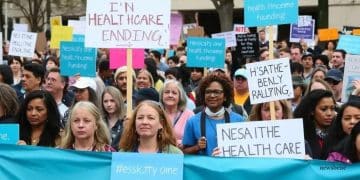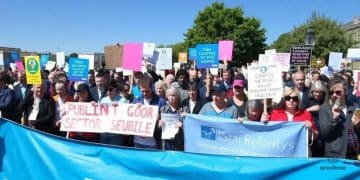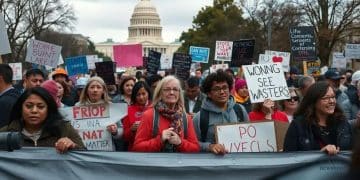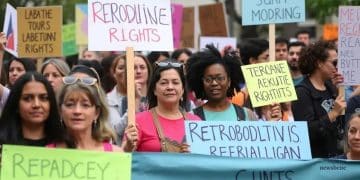Marches against restrictive immigration legislation are gaining momentum

Marches against restrictive immigration legislation mobilize communities to advocate for change, leveraging personal stories and technology to influence public policy and foster inclusivity.
Marches against restrictive immigration legislation are becoming more frequent as communities unite to demand change. This growing movement raises essential questions about inclusivity and human rights, inviting us to reflect on the impact of these gatherings.
The rise of grassroots movements
The rise of grassroots movements has transformed how communities engage with social issues, especially around immigration. These movements empower everyday people to voice concerns and advocate for change. As we see more marches against restrictive immigration legislation, it’s important to understand how grassroots efforts play a pivotal role.
Understanding Grassroots Movements
At their core, grassroots movements are driven by local communities rather than large organizations. They rally individuals around shared experiences and common goals. Many participants feel a strong connection to the issues they are tackling, often stemming from personal stories and histories. By focusing on individual narratives, these movements generate powerful advocacy that resonates across a broader audience.
Key Characteristics of Grassroots Movements
- Community engagement: Grassroots movements often involve the participation of locals who want to make a difference.
- Collaborative efforts: They bring together diverse groups, fostering unity and shared purpose.
- Bottom-up approach: Change starts at the ground level, allowing for real community input.
- Adaptive strategies: These movements can quickly respond to changing dynamics and needs within the community.
The impact of grassroots movements is evident in their ability to organize spontaneous protests and raise awareness about important issues. By mobilizing quickly, they can create pressure on lawmakers to reconsider restrictive policies. For instance, the demonstrations sparked by concern over recent immigration laws have led to increased dialogues about human rights and inclusivity.
Social media has been instrumental in amplifying these voices. Platforms allow organizers to reach a wide audience rapidly, sharing updates and rallying support. This digital aspect not only enhances visibility but also fosters a sense of solidarity among participants. It creates an environment where people feel empowered to share their stories and advocate for change.
As these grassroots movements grow, they highlight the importance of civic engagement. They remind us that every voice matters, especially in matters concerning immigration legislation. Through collaboration and determination, communities are making strides towards inclusive policies that reflect the values they uphold.
Personal stories from march participants
Personal stories from march participants provide a powerful glimpse into the human experience behind the movement. Each individual carries their unique reasons for participating in marches against restrictive immigration legislation. These narratives weave together the fabric of collective resistance and hope.
Voices of the Participants
Many participants share stories of their own or their loved ones’ struggles with immigration processes. For example, Maria, a young immigrant, recounts how her family faced challenges in securing legal status. Through her story, she highlights the fear and uncertainty that accompany such journeys. These personal anecdotes remind us that policies deeply affect real lives.
Transformative Experiences
Marches can also be transformative for those involved. Some participants find empowerment by standing alongside others who share similar backgrounds. They often express feelings of belonging and support during these gatherings. Many describe a sense of unity and understanding that encourages them to remain engaged in advocacy beyond the march.
- Building connections: Meeting others with shared experiences often turns into lifelong friendships.
- Raising awareness: Individual stories serve as powerful tools for educating others about the immigrant experience.
- Inspiring action: These narratives motivate attendees to take further action in their communities.
As participants share their stories, they contribute to a larger conversation about immigration. Their experiences foster empathy and encourage open dialogues about the importance of inclusive legislation. Each story adds depth to the issues at hand, illustrating the complexity of immigration in today’s society.
The emotional weight of these personal accounts enhances the significance of the marches. When one individual’s story resonates, it has the potential to inspire many others. The collective power of these experiences is what drives movements forward.
The role of social media in mobilizing supporters
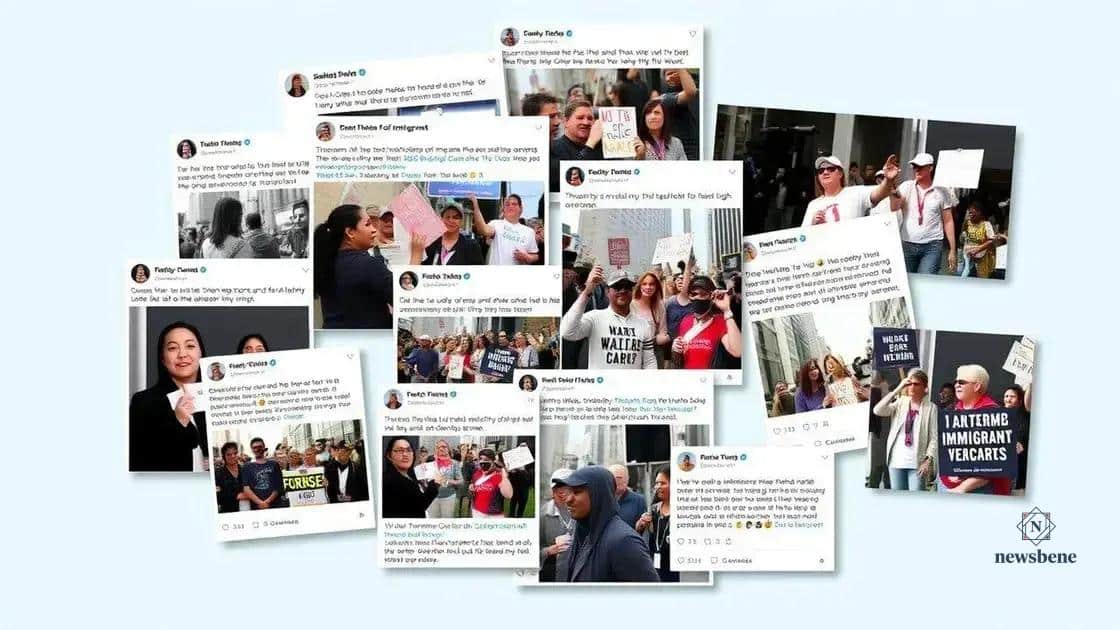
Social media plays a crucial role in mobilizing supporters for marches against restrictive immigration legislation. It has transformed how movements gather attention and organize participants. Platforms like Twitter, Facebook, and Instagram help spread messages quickly and effectively.
Connecting Communities
Through social media, individuals can connect with others who share similar values and concerns. This connection is vital for building a community ready to advocate together. Users often share personal stories, event details, and updates, creating a sense of urgency and excitement.
Spreading Awareness
Awareness campaigns can go viral, reaching a much wider audience than traditional methods. Many people discover events through friends sharing posts or using dedicated hashtags. This organic sharing increases visibility and encourages more people to join.
- Real-time updates: Organizers can provide immediate information about changes or important developments.
- Engagement: Supporters can interact with posts, showing solidarity and encouraging others to participate.
- Campaign effectiveness: Hashtags like #ImmigrantRights and #WeAreAllHuman unify efforts and make them easily searchable.
The use of multimedia, such as videos and images, enhances the impact of these messages. Engaging content is more likely to be shared, leading to exponential growth in audience reach. For example, a short clip highlighting participants’ stories can spark interest and invite others to join the cause.
Moreover, social media platforms provide a space where people can express their thoughts. Engaging in discussions around immigration policies and personal experiences can empower others. Conversations started online often lead to on-the-ground actions. Such online movements inspire those who might otherwise remain silent, encouraging them to voice their opinions.
Ultimately, social media serves as an essential tool for modern activism. It amplifies marginalized voices and fosters a sense of belonging. By leveraging these platforms, supporters of immigration reform can coordinate effectively and sustain momentum, making lasting impacts on legislative discussions.
Government responses to marches
The government responses to marches against restrictive immigration legislation often reflect a complex interplay of public sentiment and political strategy. When communities gather to protest, it captures the attention of lawmakers, raising the stakes for legislative action.
Official Statements and Actions
Government officials may issue statements during or after significant marches to acknowledge the feelings of protesters. These responses can vary widely, from supportive to dismissive. In some cases, policymakers express understanding and a willingness to engage in dialogue. In others, they may downplay the significance of the protests, insisting that current laws are necessary for security.
Policy Adjustments and Introductions
Sometimes, large-scale marches can lead to tangible political changes. For example, following widespread protests, some governments may propose new legislation aimed at reforming immigration policies. These adjustments often aim to ease the concerns brought forth by activists and community members.
- Engagement with advocacy groups: In response to protests, officials may meet with advocacy organizations to discuss potential policy changes.
- Increased funding: Governments may allocate more resources to support immigrant communities in light of concerns raised.
- Public forums: Some governments hold public forums to gather feedback and discuss reform on immigration issues.
However, the effectiveness of these responses varies. While some officials take an active approach to addressing the public’s concerns, others remain steadfast in their positions. This variability can affect the ongoing relationship between communities and lawmakers.
Additionally, the political climate often influences how government entities react to marches. In times of heightened political tension, responses may lean toward stricter enforcement of existing laws, rather than openness to reform. This can create further divisions between communities advocating for change and those in power.
Ultimately, the intersection of public protests and government action highlights the dynamic nature of social movements. Marches serve as a vital reminder to those in power that they must listen to and address the needs of their constituents. Each protest carries the potential to spark deeper conversations about how policies impact everyday lives.
Future trends in immigration legislation advocacy
Future trends in immigration legislation advocacy are evolving as activists adapt to new challenges and opportunities. As movements gain momentum, they capitalize on technology and shifts in public opinion to push for reform.
Increased Use of Technology
The role of technology in advocacy is expected to expand. Many groups are leveraging social media platforms to reach broader audiences. These tools allow for real-time engagement and mobilization. For instance, live streaming events can engage those who cannot attend in person, creating a more inclusive atmosphere.
Shifts in Public Awareness
Public perception of immigration is changing, influenced by younger generations who prioritize inclusivity. As more people become aware of the challenges facing immigrants, there is a growing push for policies that reflect these values. Advocacy groups are likely to focus on these emerging sentiments to gain support.
- Storytelling: Organizations may increasingly use personal narratives to highlight individual experiences in legislative discussions.
- Coalition Building: Combining efforts with other social justice movements can create a stronger, more unified front.
- Grassroots Mobilization: Local community organizing will continue to play a major role in shaping legislation.
The involvement of immigrant voices in discussions about their rights will also likely increase. Advocacy will center around not just public opinion but also elevating those directly impacted by immigration laws. This approach can lead to more effective and compassionate policies.
Additionally, there may be a rise in legal advocacy initiatives. Organizations could provide more resources for immigrants to navigate the complex legal landscape. Empowering individuals through knowledge will be crucial in driving positive change.
As the landscape of immigration legislation advocacy shifts, adaptive strategies will become vital. Grassroots movements will continue to be a powerful force, focusing on impactful storytelling, coalition-building, and leveraging technology to amplify their message and achieve reform.
FAQ – Frequently Asked Questions about Immigration Legislation Advocacy
What are grassroots movements in immigration advocacy?
Grassroots movements are community-driven efforts where individuals unite to advocate for immigration reform and raise awareness about related issues.
How does technology influence immigration advocacy?
Technology enhances outreach and mobilization, allowing activists to connect with broader audiences through social media and other platforms.
Why are personal stories important in this advocacy?
Personal stories provide a human perspective that can resonate more deeply with the public, helping to raise awareness and foster empathy regarding immigration issues.
What are future trends in immigration legislation advocacy?
Future trends include increased collaboration between movements, greater use of technology, and a focus on empowering affected individuals in discussions about immigration policies.

